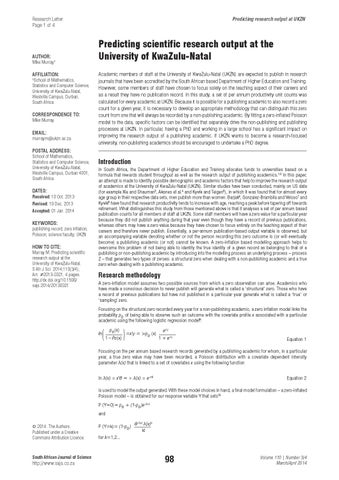Research Letter Page 1 of 4
AUTHOR:
Mike Murray1
AFFILIATION:
School of Mathematics, Statistics and Computer Science, University of KwaZulu-Natal, Westville Campus, Durban, South Africa 1
CORRESPONDENCE TO: Mike Murray
EMAIL:
murraym@ukzn.ac.za
Predicting research output at UKZN
Predicting scientific research output at the University of KwaZulu-Natal Academic members of staff at the University of KwaZulu-Natal (UKZN) are expected to publish in research journals that have been accredited by the South African based Department of Higher Education and Training. However, some members of staff have chosen to focus solely on the teaching aspect of their careers and as a result they have no publication record. In this study, a set of per annum productivity unit counts was calculated for every academic at UKZN. Because it is possible for a publishing academic to also record a zero count for a given year, it is necessary to develop an appropriate methodology that can distinguish this zero count from one that will always be recorded by a non-publishing academic. By fitting a zero-inflated Poisson model to the data, specific factors can be identified that separately drive the non-publishing and publishing processes at UKZN. In particular, having a PhD and working in a large school has a significant impact on improving the research output of a publishing academic. If UKZN wants to become a research-focused university, non-publishing academics should be encouraged to undertake a PhD degree.
POSTAL ADDRESS:
School of Mathematics, Statistics and Computer Science, University of KwaZulu-Natal, Westville Campus, Durban 4001, South Africa
DATES:
Received: 10 Oct. 2013 Revised: 19 Dec. 2013 Accepted: 01 Jan. 2014
KEYWORDS:
publishing record; zero inflation; Poisson; science faculty; UKZN
HOW TO CITE:
Murray M. Predicting scientific research output at the University of KwaZulu-Natal. S Afr J Sci. 2014;110(3/4), Art. #2013-0321, 4 pages. http://dx.doi.org/10.1590/ sajs.2014/20130321
Introduction In South Africa, the Department of Higher Education and Training allocates funds to universities based on a formula that rewards student throughput as well as the research output of publishing academics.1,2 In this paper, an attempt is made to identify possible demographic and academic factors that help to improve the research output of academics at the University of KwaZulu-Natal (UKZN). Similar studies have been conducted, mainly on US data (for example Xie and Shauman3, Aksnes et al.4 and Kyvik and Teigen5), in which it was found that for almost every age group in their respective data sets, men publish more than women. Barjak6, Gonzalez-Brambila and Veloso7 and Kyvik8 have found that research productivity tends to increase with age, reaching a peak before tapering off towards retirement. What distinguishes this study from those mentioned above is that it analyses a set of per annum based publication counts for all members of staff at UKZN. Some staff members will have a zero value for a particular year because they did not publish anything during that year even though they have a record of previous publications, whereas others may have a zero value because they have chosen to focus entirely on the teaching aspect of their careers and therefore never publish. Essentially, a per-annum publication-based output variable is observed, but an accompanying variable denoting whether or not the person recording this zero outcome is (or will eventually become) a publishing academic (or not) cannot be known. A zero-inflation based modelling approach helps to overcome this problem of not being able to identify the true identity of a given record as belonging to that of a publishing or non-publishing academic by introducing into the modelling process an underlying process – process Z – that generates two types of zeroes: a structural zero when dealing with a non-publishing academic and a true zero when dealing with a publishing academic.
Research methodology A zero-inflation model assumes two possible sources from which a zero observation can arise. Academics who have made a conscious decision to never publish will generate what is called a ‘structural’ zero. Those who have a record of previous publications but have not published in a particular year generate what is called a ‘true’ or ‘sampling’ zero. Focusing on the structural zero recorded every year for a non-publishing academic, a zero inflation model links the probability po of being able to observe such an outcome with the covariate profile x associated with a particular academic using the following logistic regression model9: In
( 1 – oPo(x) ( =x'γ = >po (x) 1 +e e p (x)
x'γ
x'γ
Equation 1
Focusing on the per annum based research records generated by a publishing academic for whom, in a particular year, a true zero value may have been recorded, a Poisson distribution with a covariate dependent intensity parameter λ(x) that is linked to a set of covariates x using the following function In λ(x) = x'θ = > λ(x) = e x'θ
Equation 2
is used to model the output generated. With these model choices in hand, a final model formulation – a zero-inflated Poisson model – is obtained for our response variable Y that sets13 P (Y=0)= po + (1-po)e-λ(x) and © 2014. The Authors. Published under a Creative Commons Attribution Licence.
South African Journal of Science
http://www.sajs.co.za
P (Y=k)= (1-po)
θ-λ(x) λ(x)k k!
for k=1,2...
98
Volume 110 | Number 3/4 March/April 2014
